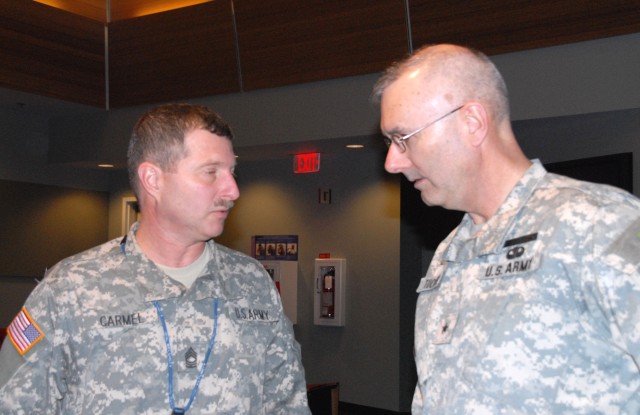WASHINGTON (Army News Service, Feb. 20, 2008) - The Army is ready to launch a new phase in caring for wounded warriors, the assistant surgeon general for warrior care and transition told Soldiers and Army Civilians during an Army Leader Forum at the Pentagon Tuesday.
Brig. Gen. Mike Tucker announced that the Comprehensive Care Plan is scheduled to begin March 1, and will focus on healing the whole person - body, mind, heart and spirit - and not just physical well-being.
The program will include educational, vocational and life-skills development, leadership and mentoring, relationship coaching and behavior-health treatment in addition to medical treatment and physical and occupational therapy.
Also as of March 1, Tucker said, Soldiers in Warrior Transition Units will not be allowed to waste time playing video games or watching mindless cartoons during duty hours. They are still Soldiers in the Army, Tucker said, and their one mission is to heal: to go to their appointments, take their medications and now participate in cognitive-enhancing activities or a structured-work program, if able.
"We want them to return to duty or return to be a citizen in society and be successful and be proud of their service," he said. "If we're not careful, we'll raise a generation, 10-15 years from now, that will be panhandling because they don't have any life skills.
"It's important that we give these kids life skills. They all want to be something in life, other than what they are right now. They have to aspire. We have to allow them to achieve all they can be and provide them the structure at a time in their lives when they need it the most."
The WTU return-to-duty rate is over 70 percent he added, the equivalent of two brigade combat teams each year. Eighty-eight percent of those Soldiers are between the ranks of corporal or specialist and sergeant first class, an incredible amount of experience, Tucker said. The Army hasn't denied one continued-on-active-duty applicant since the beginning of the war.
To ensure they make their appointments and take medications, each Soldier in the Army's 35 WTUs has a squad leader (one per 12 Soldiers), a nurse-case manager (one per 18 Soldiers) and a primary care manager (one per 200 Soldiers), who communicate frequently.
Squad leaders and other WTU cadre are selected based on their leadership abilities and receive training on leading wounded Soldiers. They're there to help Soldiers with orders, pay, housing concerns - any logistics problems.
All of this is part of Tucker and the Army's crusade to break down the bureaucracy that the Washington Post exposed in February 2007. Outdated regulations, dwindling resources, fewer hospitals and an unprecedented-survival rate created what Tucker calls a "perfect storm" that no one knew existed.
"People we should be caring for the most, we were caring for the least, institutionally," he said, acknowledging that many of the same problems existed Army-wide, but that WTUs and additional funding have fixed many of them.
He still faces the bureaucracy head-on, often encountering problems no one could have forseen, like the injured Soldier who was initially told he was no longer entitled to his re-enlistment bonus.
Tucker said the problem was immediately fixed, and while Army employees may have been following a regulation to the letter, it's more important for them to stop and say 'Wait a minute, this doesn't seem right. Let me talk to my boss.'
"So when we came to impasses on what we were going to do with bureaucracy, I would always err on the side of healing," he said.
"Well, the Soldiers at Fort Bragg don't want to come to the WTU because they can't wear their maroon beret. 'Why can't they'' Because Army Regulation says they can't. 'But why can't they' Is it legal, moral and ethical'' Well, not really. 'Well, make your folks aware that they can now wear it.' "
"Some Soldiers said 'I don't want to go there because I can't wear my patch. I want to wear the 101st patch. I'm a 10th Mountain <i>Climb to Glory</i> Soldier. Don't make me wear the MEDCOM patch. I went to war with these Soldiers. I fought. I bled with these Soldiers. I don't want to lose my identity.' Is that part of making them feel good' Is that part of healing' They can wear their patch now.
"'Well, I don't want to go to the WTU, because if I go to the WTU, I won't get back to my unit and I want to get back to my unit because those are the Soldiers I fought with, I bled with.' So now we've authorized them to go back to their unit, even if it's in an over-strength status. We're busting bureaucracy on the side of healing. If it makes you feel better, that's fine."
Wounded warriors who decide to leave the Army now have 90 days to transition to Veterans Affairs and Army representatives help walk them through the process and introduce them to VA, making sure they know what their benefits are. Soldiers will receive their first check from the VA on the first day of the next month after they've transitioned.
To further smooth the process between Army and VA, Tucker's executive officer, Dr. (Lt. Col.) Marie Dominguez, is going to serve as a special advisor to VA Secretary James Peake. Tucker will also have a special advisor from the VA.
"This is profound, because now I have a camel in their tent, so to speak. So we're starting to focus on the VA and get some more traction with them because we want to carry this continuum of care onto them," he said.


Social Sharing